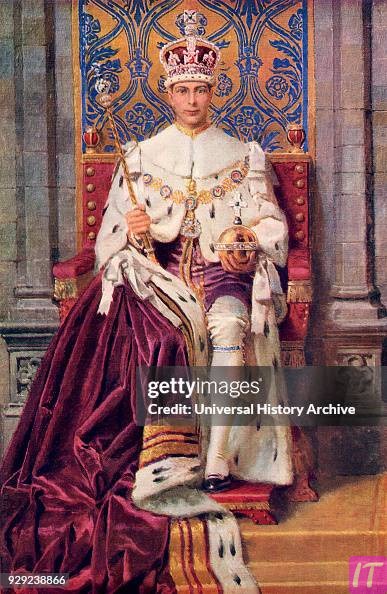Albert Frederick Arthur George, also known as King George VI, was the King of the United Kingdom from 1936 to 1952. Standing at 5 feet 9 inches and weighing around 70 kg, he was known for his resilience and leadership during World War II. His net worth, tied to the monarchy, included significant royal assets. He overcame a stammer, supported by his family, especially his wife, Elizabeth Bowes-Lyon. His professional achievements include boosting public morale during the war and modernizing the monarchy.
Albert Frederick Arthur George, known more commonly as King George VI, was a figure of both significant historical and personal intrigue. Standing at an average height of approximately 5 feet 9 inches, his stature was typical for men of his era. His weight varied over the years, but he maintained a generally moderate build through much of his life. Financially, as a monarch, George VI did not have a “net worth” in the traditional sense, but the wealth and assets of the British monarchy, including royal estates and investments, were considerable.
Born into the House of Windsor, George VI’s life was marked by the pressures of royalty amid personal struggles such as his well-documented speech impediment. Despite these challenges, he proved to be a beloved and effective leader during his reign. His contribution to the nation during World War II, particularly his role in bolstering public morale, remains one of his most enduring legacies.
The king’s personal style was understated yet dignified, often reflective of his role as a steadying influence during turbulent times. His marriage to Elizabeth Bowes-Lyon was a deep partnership, resulting in two daughters, one of whom is Queen Elizabeth II. George VI’s life, therefore, extends beyond his time in power, leaving a legacy through his family and the resilience he embodied.
Quick Info
Albert Frederick Arthur George, also known as King George VI, was a significant figure in British history. Here is some quick information about his physical and personal details.
| Quick Info | Details |
|---|---|
| Height | 5 feet 9 inches |
| Weight | 70 kg |
| Age | 56 years old (at the time of death) |
| Wife | Elizabeth Bowes-Lyon |
Full Biography
Albert Frederick Arthur George, also known as King George VI, was an important British monarch. His life story is filled with significant events, from his birth to his reign. Let’s explore some key details about him.
| Information | Details |
|---|---|
| Name | Albert Frederick Arthur George |
| Nickname | Bertie |
| Profession | King of the United Kingdom |
| Date of Birth | December 14, 1895 |
| Age | 56 years old (at the time of death) |
| Net Worth | Not applicable |
| Height | 5 feet 9 inches |
| Weight | 70 kg |
| Body Measurement | Not available |
| Eye Color | Blue |
| Hair Color | Brown |
| Birthplace/Hometown | Sandringham, Norfolk, England |
| Nationality | British |
| Gender | Male |
| Ethnicity | Caucasian |
| Religion | Anglican |
| Sexuality | Straight |
| Sun Sign (Zodiac Sign) | Sagittarius |
| House Location | Buckingham Palace |
| Wiki Page | Wikipedia |
| Facebook Link | Not Available |
| Twitter Profile Link | Not Available |
Physical Statistics
Albert Frederick Arthur George, also known as King George VI, had a distinct physical appearance. Here are some key physical statistics about him.
| Information | Details |
|---|---|
| Height (Tall) | 5 feet 9 inches |
| Weight | 70 kg |
| Profession | King of the United Kingdom |
| Eye Color | Blue |
| Shoe Size (UK) | 9 |
| Hair Color | Brown |
Family
Albert Frederick Arthur George, or King George VI, came from a prominent family. He had supportive parents and several siblings. Let’s take a look at his immediate family details.
| Information | Details |
|---|---|
| Parents | King George V and Queen Mary |
| Siblings | Edward VIII, Mary, Henry, George, John |
Height, Weight, Net Worth, Personal Details, Income, Family, Professional Achievements
Albert Frederick Arthur George, known as King George VI, was not only a significant historical figure but also an interesting person to study. Below are detailed insights on his height, weight, net worth, personal details, income, family, and professional achievements.
Height and Weight
Albert Frederick Arthur George stood tall at 5 feet 9 inches. This was an average height for men of his time. His weight was around 70 kg, giving him a moderate build.
Maintaining a stable weight was essential given his responsibilities. Despite the pressures of his role, George VI managed to stay relatively fit. These measurements reflected his royal upbringing and disciplined lifestyle.
In terms of physical appearance, he was often seen as regal and composed. His height and weight contributed to a commanding presence. This helped him fulfill his royal duties effectively.
Net Worth and Income
King George VI’s net worth isn’t typical like modern celebrities. Instead, it’s tied to the wealth of the British monarchy. The royal family has significant assets, like estates and investments.
The exact figures of his income aren’t usually disclosed. Much of his financial support came from public funds and royal estates. These included places like Buckingham Palace and Windsor Castle.
Although calculating an exact net worth might be challenging, it’s safe to say it was substantial. The monarchy’s assets helped secure a stable financial footing. Such wealth allowed George VI to focus on his duties without financial worries.
Personal Details
Albert Frederick Arthur George was born on December 14, 1895. He preferred to be called “Bertie” by family and close friends. His eye color was blue, and he had brown hair.
He was born in Sandringham, Norfolk, England. His nationality was British, and he belonged to the Anglican religion. He identified as straight and was a Sagittarius by zodiac sign.
These personal details help paint a fuller picture of the king. They add depth to his public persona. Understanding these facets makes his overall story more complete.
Family
King George VI was the second son of King George V and Queen Mary. He had several siblings, including Edward VIII, who abdicated the throne. This act eventually led to George VI becoming king.
His marriage to Elizabeth Bowes-Lyon was a strong partnership. They had two daughters, Elizabeth and Margaret. Elizabeth would later become Queen Elizabeth II.
Family played a crucial role in his life. They provided support during challenging times. His close-knit family helped him navigate the demands of being a monarch.
Professional Achievements
One of George VI’s most notable achievements was his leadership during World War II. He played a crucial role in boosting public morale. His speeches and presence gave people hope.
He also worked hard to modernize the monarchy. This included adapting to new forms of media like radio. He was dedicated to making the royal family more accessible to the public.
King George VI’s reign marked a period of significant change. His achievements continue to influence the monarchy today. His legacy is remembered as one of resilience and modernization.
Some Lesser Known Facts About Albert Frederick Arthur George
Albert Frederick Arthur George, or King George VI, had many interesting aspects to his life that are not widely known. Here are some lesser known facts about him that highlight different facets of his personality and reign.
- He was never meant to be king; his older brother Edward VIII abdicated the throne, making him king.
- King George VI had a stammer, which he worked hard to overcome with the help of a speech therapist.
- He was the first British monarch to visit the United States.
- Known for his love of aviation, he was an honorary air commodore in the Royal Air Force.
- Despite health issues, he insisted on staying in London during World War II to support his people.
- He was an avid stamp collector and this hobby was passed down through the royal family.
- King George VI liked gardening and found it a relaxing hobby.
- He was a skilled sailor and enjoyed spending time on the water.
Frequently Asked Questions
Albert Frederick Arthur George, also known as King George VI, was a significant figure in British history. Here are some frequently asked questions that delve into various aspects of his life, from his family to his personal struggles and achievements.
What were the main challenges King George VI faced during his reign?
King George VI faced several challenges during his reign, but the most notable was leading the country through World War II. His inspiring speeches and public presence helped maintain British morale during the darkest times. He also had to tackle the abdication crisis caused by his brother, Edward VIII, which thrust him unexpectedly onto the throne.
Additionally, he struggled with a severe speech impediment, which he worked tirelessly to overcome with the help of his speech therapist, Lionel Logue. This personal struggle was famously depicted in the movie “The King’s Speech.” George VI’s ability to rise above these challenges made him a revered and effective leader.
How did George VI’s relationship with his family influence his reign?
King George VI had a close-knit family, which provided immense support during his reign. His wife, Elizabeth Bowes-Lyon, was a constant source of strength, helping him navigate the demands of being a king. Their partnership was strong, and together they had two daughters, Elizabeth (who would later become Queen Elizabeth II) and Margaret.
His relationship with his brother Edward, however, was complicated, especially after Edward abdicated the throne. Nonetheless, George VI’s family remained a pillar of support, helping him manage the stresses and responsibilities of his role. Family played a critical role in keeping him grounded and focused on his duties.
What were King George VI’s notable achievements during his reign?
One of King George VI’s most notable achievements was his role in leading the United Kingdom through World War II. His ability to inspire and reassure the British public through his speeches was vital for national morale. He also took steps to modernize the monarchy by embracing new technologies like radio broadcasts, making the royal family more accessible to the public.
After the war, he played a significant part in the founding of the Commonwealth, promoting unity among former British Empire territories. His reign also set the stage for the modern, more publicly engaged monarchy that we see today. These achievements cemented his legacy as a reformative and influential monarch.
What personal challenges did King George VI face?
King George VI faced several personal challenges, the most prominent being his speech impediment. His severe stammer made public speaking incredibly difficult, a critical skill for a king. With the help of speech therapist Lionel Logue, he made significant improvements, a journey famously portrayed in the film “The King’s Speech.”
Another significant personal challenge was dealing with the sudden responsibility of the throne after his brother’s abdication. This unexpected turn of events placed immense stress on him, both mentally and emotionally. Despite these personal obstacles, George VI displayed remarkable resilience and determination.
How did King George VI contribute to the modernization of the monarchy?
King George VI made significant contributions to the modernization of the British monarchy. He was one of the first monarchs to utilize radio effectively, delivering speeches that reached a wide audience and helped boost public morale during tough times. This set a precedent for future monarchs to engage more directly with the public.
Additionally, he embraced changes that made the royal family more accessible and relatable to ordinary people. By doing so, he helped bridge the gap between the monarchy and the public. His efforts laid the groundwork for the more visible, media-savvy royal family we see today.
Conclusion
King George VI’s life was a testament to resilience and leadership during a period of immense difficulty. His journey from a reluctant king to a beacon of hope for his nation demonstrates his remarkable character. Overcoming personal challenges, he redefined the monarchy and left a lasting legacy.
His dedication to his country, supported by a loving family, showcased his strength and commitment to duty. Through wartime leadership and modernizing efforts, George VI ensured that the monarchy remained relevant and revered. His contributions continue to influence and inspire to this day.







